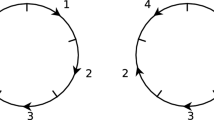Abstract
The variation in genome arrangements among bacterial taxa is largely due to the process of inversion. Recent studies indicate that not all inversions are equally probable, suggesting, for instance, that shorter inversions are more frequent than longer, and those that move the terminus of replication are less probable than those that do not. Current methods for establishing the inversion distance between two bacterial genomes are unable to incorporate such information. In this paper we suggest a group-theoretic framework that in principle can take these constraints into account. In particular, we show that by lifting the problem from circular permutations to the affine symmetric group, the inversion distance can be found in polynomial time for a model in which inversions are restricted to acting on two regions. This requires the proof of new results in group theory, and suggests a vein of new combinatorial problems concerning permutation groups on which group theorists will be needed to collaborate with biologists. We apply the new method to inferring distances and phylogenies for published Yersinia pestis data.







Similar content being viewed by others
References
Bader D, Moret B, Yan M (2001) A linear-time algorithm for computing inversion distance between signed permutations with an experimental study. J Comput Biol 8(5):483–491
Bafna V, Pevzner P (1993) Genome rearrangements and sorting by reversals. In IEEE proceedings of the 34th annual symposium on the foundations of computer science, pp 148–157
Bergeron A, Mixtacki J, Stoye J (2006) A unifying view of genome rearrangements. Lect Notes Comput Sci 4175:163–173
Bos K, Schuenemann V, Golding G, Burbano H, Waglechner N, Coombes B, McPhee J, DeWitte S, Meyer M, Schmedes S et al (2011) A draft genome of yersinia pestis from victims of the black death. Nature 478(7370):506–510
Dalevi DA, Eriksen N, Eriksson K, Andersson SGE (2002) Measuring genome divergence in bacteria: a case study using chlamydian data. J Mol Evol 55(1):24–36
Darling A, Miklós I, Ragan M (2008) Dynamics of genome rearrangement in bacterial populations. PLoS Genet 4(7)
Darling AE, Mau B, Perna NT (2010) progressivemauve: multiple genome alignment with gene gain, loss and rearrangement. PLoS One 5(6):e11147
Eisen JA, Heidelberg JF, White O, Salzberg SL (2000) Evidence for symmetric chromosomal inversions around the replication origin in bacterial. Genome Biol 1(6)
Felsenstein J (1989) Phylip-phylogeny inference package (version 3.2). Cladistics 5:164–166
Fertin G, Labarre A, Rusu I, Tannier É, Vialette S (2009) Combinatorics of genome rearrangements. MIT press, Cambridge
GAP (2012) GAP–groups, algorithms, and programming, Version 4.5.6. The GAP Group
Hannenhalli S, Pevzner P (1995) Transforming men into mice (polynomial algorithm for genomic distance problem). In: 36th annual symposium on foundations of computer science, 1995. Proceedings, pp 581–592
Humphreys JE (1990) Reflection groups and Coxeter groups. Cambridge University Press, Cambridge
Kawai M, Nakao K, Uchiyama I, Kobayashi I (2006) How genomes rearrange: Genome comparison within bacteria Neisseria suggests roles for mobile elements in formation of complex genome polymorphisms. Gene 383:52–63
Kececioglu J, Sankoff D (1993) Exact and approximation algorithms for the inversion distance between two chromosomes. In: Lecture notes in computer science. Springer, Berlin
Lefebvre JF, El-Mabrouk N, Tillier E, Sankoff D (2003) Detection and validation of single gene inversions. Bioinformatics 19(Suppl 1):i190–i196
Lusztig G (1983) Some examples of square integrable representations of semisimple \(p\)-adic groups. Trans Am Math Soc 277(2):623–653
Meidanis J, Dias Z (2000) An alternative algebraic formalism for genome rearrangements. Empirical and analytical approaches to gene order dynamics, map alignment and evolution of gene families, comparative, genomics, pp 213–223
Moulton V, Steel M (2012) The ‘Butterfly effect’ in Cayley graphs with applications to genomics. J Math Biol 65(6–7):1267–1284
Ohlebusch E, Abouelhoda M, Hockel K, Stallkamp J (2005) The median problem for the reversal distance in circular bacterial genomes. In: Combinatorial pattern matching. Lecture notes in computer science. Springer, Berlin
Pinter R, Skiena S (2002) Sorting with length-weighted reversals. In: Proc. 13th international conference on genome informatics (GIW 2002), pp 173–182
Rocha EPC (2006) Inference and analysis of the relative stability of bacterial chromosomes. Mol Biol Evol 23(3):513–522
Saitou N, Nei M (1987) The neighbor-joining method: a new method for reconstructing phylogenetic trees. Mol Biol Evol 4(4):406–425
Shi J (1986) The Kazhdan-Lusztig cells in certain affine Weyl groups. Springer, Berlin
Shi J (1994) Some results relating two presentations of certain affine Weyl groups. J Algebra 163(1):235–257
Swidan F, Bender M, Ge D, He S, Hu H, Pinter R (2004) Sorting by length-weighted reversals: Dealing with signs and circularity. In: Combinatorial pattern matching. Lecture notes in computer science. Springer, Berlin
Watterson GA, Ewens WJ, Hall TE, Morgan A (1982) The chromosome inversion problem. J Theoret Biol 99(1):1–7
Author information
Authors and Affiliations
Corresponding author
Additional information
This research was partially funded by Australian Research Council Discovery Grants DP0987302 and DP130100248, and Australian Research Council Future Fellowship FT100100898.
Rights and permissions
About this article
Cite this article
Egri-Nagy, A., Gebhardt, V., Tanaka, M.M. et al. Group-theoretic models of the inversion process in bacterial genomes. J. Math. Biol. 69, 243–265 (2014). https://doi.org/10.1007/s00285-013-0702-6
Received:
Revised:
Published:
Issue Date:
DOI: https://doi.org/10.1007/s00285-013-0702-6




